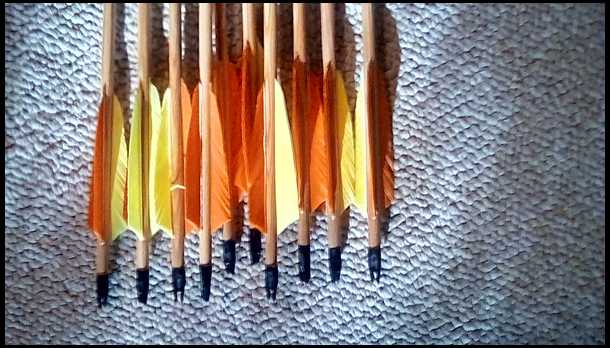| From: Carolinabob
|
|
|
|
|
|
|
| Date: 16-Jun-18 |
|
Anyone use a shooting board to hand plane arrow shafts,if so what type of Wood?
|
|
|
|
| From: CStyles
|
|
|
|
|
|
|
| Date: 16-Jun-18 |
|
I use essentially a vee block to hold the blank and a small hand plane. Typically Select Pine from home depot, Douglas fir, or poplar. Obviously select a board with straight tight grain Chuck S
|
|
| From: Snag
|

|
|
|
|
|
|
| Date: 16-Jun-18 |
|
Chuck how many shafts, on average, do you have to make in order to get a dozen that match within 5# spine and 10 grs? Or better yet how many boards?
|
|
| From: CStyles
|
|
|
|
|
|
|
| Date: 16-Jun-18 |
|

Typically i get at least 20 blanks from a 3/4" x 4" x 6' board. Usually 4 of the blanks are crap, so 16 finished shafts are typical. I have a jig set up on my belt sander to take the blanks from octagonal to round. I finish sand to match weight and spine. Usually 14 shafts match within 10 grains. The last board I bought was Douglas fir cost $6.29. Sometimes a board is total deal due to soft spots about 4" from the ends. The last 2 poplar boards I bought were bad like that. the most consistent results have been with the home depot select pine. Pick a straight board with straight grain and at least 6 growth rings and the shafts come out at 350 grains, 50 lb spine, an finish at 500 grains. Perfect for my 50lb bows. The Douglas for is typically heavier, about 550-575 for a finished arrow. Since it is wood it does vary somewhat board to board. Douglas for arrows in the picture.
|
|
| From: fdp
|
|
|
|
|
|
|
| Date: 16-Jun-18 |
|
Snag, I don't know how other people do it but I can make virtually every shaft match within 4lbs. simply by altering the diameter a little. And weigh it matched by breast tapering.
|
|
| From: George Tsoukalas
|
|
|
|
|
|
|
| Date: 16-Jun-18 |
|
Sure do.
http://traditionalarchery101.com/shafts.html
Jawge
|
|
| From: CStyles
|
|
|
|
|
|
|
| Date: 16-Jun-18 |
|
Worth noting Jawge's site to me started many years ago. Thanks Jawge! Chuck S
|
|
|
|
| From: Bill Rickvalsky
|
|
|
|
|
|
|
| Date: 17-Jun-18 |
|
Chuck, would you happen to have a picture of the jig you made for your belt sander for rounding the shafts?
Jawge, went to your site. Lots of nice information. But maybe I am just to dense but I can't seem to picture what your mean by:
"Hold the shaft in your hand with the plane on top to reduce the ends to the width you desire."
|
|
| From: George Tsoukalas
|
|
|
|
|
|
|
| Date: 17-Jun-18 |
|
Sorry, Bill. I hold the shaft in my left hand and the little one inch thumb plane in my right towards the index and middle finger. Then I plane away while turning the shaft slightly. Jawge
|
|
| From: Bill Rickvalsky
|
|
|
|
|
|
|
| Date: 17-Jun-18 |
|
OK, I get it now. I guess what contributed to my confusion is that I would not have expected you to just hold it purely by hand at that point. I was thinking you must use some sort of stabilizing support. I need to look into picking up a thumb plane. The smallest plane I have right now is a low angle block plane I use for board edge finishing.
|
|
| From: Jim Davis
|
|
|
|
|
|
|
| Date: 17-Jun-18 |
|
Even if you don't use any power tools, it's mighty useful to finish up with what is called a sanding book. It's two blocks of wood hinged together like a book and has a hole that has half it's diameter in each block |(o)|. The hole is lined with sandpaper. Slip the shaft into the "book" and slide it back and forth while turning it. Or spin the shaft in a drill and apply the block.
Native Americans used two pieces of sandstone for the same purpose.
|
|
| From: CStyles
|
|
|
|
|
|
|
| Date: 17-Jun-18 |
|
Here is my belt sander setup https://www.youtube.com/watch?v=Mu40D_w_--s I also posted a video making a footed shaft per Jawge's instructions. It is more detailed than it needs to be. The planing part starts at about 23 minutes. https://www.youtube.com/watch?v=yJspZ7ZJfkc&t=12s
|
|
| From: Thogg
|
|
|
|
|
|
|
| Date: 17-Jun-18 |
|
Does Poplar make good shafts? Is it durable is it strong? As a finish Carpenter there's lots of Poplar waste, and I'd be glad to repurpose it if it's viable.
|
|
| From: Sailor
|
|
|
|
|
|
|
| Date: 17-Jun-18 |
|
I make poplar arrow shafts out of poplar lumber. It makes excellent durable arrows. I have always like doug fir but I am starting to like poplar better.
|
|
| From: CStyles
|
|
|
|
|
|
|
| Date: 17-Jun-18 |
|
I really like poplar, I had bad luck with the last 2 boards I bought but have made many good shafts in the past. I have even found some straight grained dowels that I sanded down to spine. Very durable
|
|
If you have already registered, please sign in now
For new registrations Click Here
|
|
|
|



